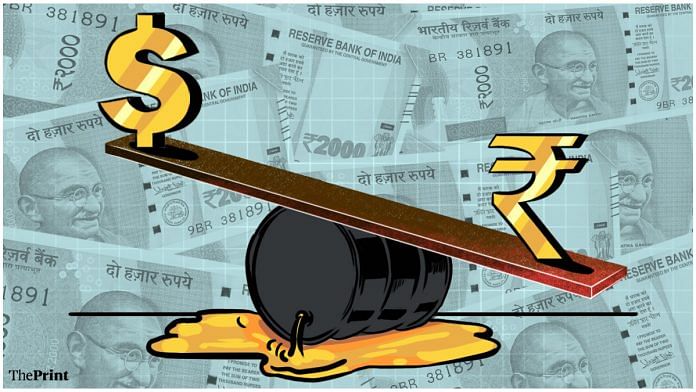Earlier this week, the rupee slumped close to 77 per dollar mark, falling over 1 per cent in a day amid surging oil prices and consistent outflows of foreign portfolio flows.
The Russia-Ukraine crisis has led to a rush towards safe haven assets such as gold and the US dollar. Investors are selling riskier assets such as Indian equities. Since the beginning of this year, foreign investors have pulled out roughly $13 billion from the Indian stock market. This is likely to keep the dollar stronger and could drive down the rupee further.
Crude oil prices surged past $130 per barrel, hitting their highest levels in 14 years. The supply disruption due to sanctions on Russia has come at a time when top oil producers have committed to only a modest rise in monthly oil production.
If oil prices stay elevated at $100 per barrel for a prolonged period, it could lead to a 1 per cent rise in inflation. India’s current account is estimated to rise to 2.8 percent of GDP in the October-December quarter from 1.3 percent of GDP in the previous quarter.
Rupee is likely to remain on a weaker trajectory as long as oil and energy prices remain high. For prices to cool, supply needs to increase. Oil producers can quickly pump out more crude oil so prices may come down soon. In a few weeks we will see whether this starts happening.
Also read: Rajasthan’s pension system reversal is anti-reform, it will reintroduce inequality
How sharp is the rupee depreciation?
Rupee was showing signs of depreciation even before the Russian invasion of Ukraine. Speculation of aggressive rate hikes by the US Federal Reserve amid a sharp increase in inflation in the US led to weakening of the rupee since the middle of February.
Since the onset of the geopolitical conflict, the currencies of major oil-importers such as India and the European Union (EU) have taken a hit.
While the rupee was showing signs of weakness since the middle of February, the ongoing conflict has led to a sharper pace of depreciation for the euro as compared to the rupee. In fact, the latest data shows that the rupee has appreciated against the euro.
Implications of rupee depreciation
Depreciation of the rupee is likely to make imports more expensive for India, which meets more than two-thirds of its domestic oil requirements through imports. India is also one of the top importers of edible oils. A weaker currency will further escalate imported edible oil prices and lead to a higher food inflation.
While a weaker rupee should theoretically give a boost to India’s exports, but in an environment of uncertainty and weak global demand, a fall in the external value of rupee may not translate into higher exports.
In the current environment of currency volatility, exporters are not sure if they should lock their export orders at the prevailing exchange rate. It may well be that the rupee depreciates further. In that scenario, entering into export agreement at the prevailing rates may make them worse off.
Some of India’s export items such as gems and jewellery, chemicals and automobiles have high import content. With rising commodity prices, the cost of production for exports will also go up.
Also read: Indian economy was recovering after Omicron but Russia-Ukraine crisis can spoil the party
Challenges for RBI
The uncertainty around the current events is creating challenges for the Reserve Bank of India (RBI). If the current trend of escalating oil prices and fall in the value of the rupee lasts for a few weeks, RBI can use its foreign $631 billion worth exchange reserves to prevent the rupee slide. The RBI is estimated to have already sold $2 billion to curb the wild swings in the rupee.
On Tuesday, the RBI also conducted a $5 billion-rupee swap auction as part of its liquidity management to infuse dollars and suck out the rupee. The RBI sold $5.135 billion to banks and agreed to buy back the dollars at the end of two years. In the process, it sucked out rupee liquidity worth $5.135 billion at the rate of 76.91 per dollar. The central bank’s intervention will reduce the pressure on the rupee and help in moderating imported inflation. After the swap auction, the rupee recovered some of its lost ground.
Intervention to arrest the rupee slide is consistent with the reversal of the ultra-accommodative monetary policy which many central banks have undertaken in the recent months.
While the RBI announced a dovish policy and stayed away from hiking interest rates, the intervention and swap auction will have the desired impact of normalising monetary policy through liquidity absorption.
While markets might expect RBI to conduct interventions and swap auctions to shield the rupee, if volatility due to the geopolitical tensions continue for long, RBI may have to allow the rupee to slide. If the market feels that it is not doing so and is trying to keep the rupee strong, there could be a speculative attack on the rupee as it is not a sustainable strategy when India has a higher inflation rate, lower interest rates and will not be comfortable losing over $100 billion or $200 billion.
In the meanwhile, RBI may intervene to curb volatility but not sell in a very big way if the pressure increases. So far that looks unlikely.
Ila Patnaik is an economist and a professor at National Institute of Public Finance and Policy.
Radhika Pandey is a consultant at NIPFP.
Views are personal.
Also read: RBI’s double-edged decision — not hiking rates helps govt borrow, but runs inflationary risk



